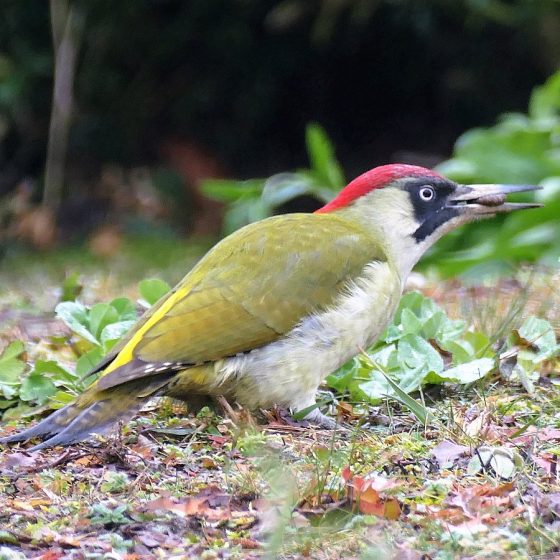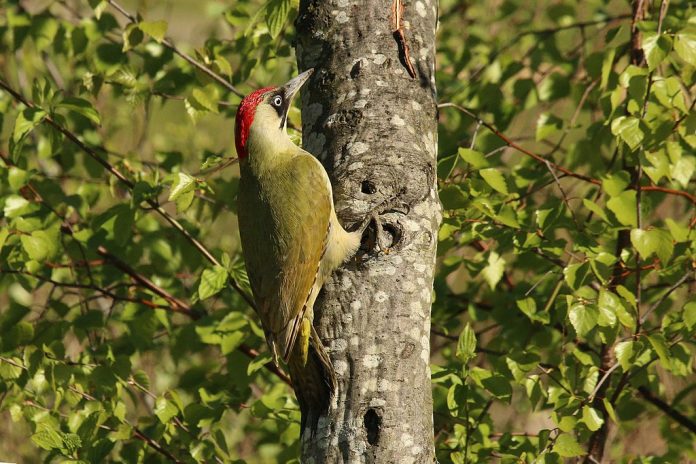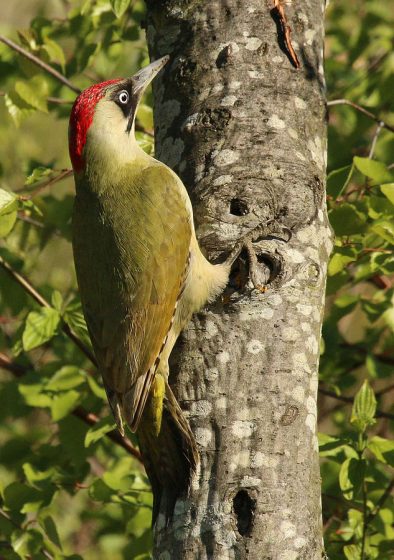DESCRIPTION
The European Green Woodpecker is a medium-sized bird that is found throughout Europe and parts of Asia. They are easily recognizable by their green and black plumage, and their loud “yaffle” call. These birds inhabit a wide variety of habitats, from forests to urban areas. In this blog post, we will discuss the European Green Woodpecker in more detail, including their diet, behavior, and conservation status.
IDENTIFICATION
EUROPEAN GREEN WOODPECKER is a large woodpecker that is the most widespread green-type species in the European region. Characteristic adult European Green Woodpecker can be separated from other green types by a combination of all-red crown and nape and solid black mask between the crown and malar stripe.
The juvenile bird is unlikely to be confused, as has a unique pattern of heavy dark markings on the face, sides of the neck, and underparts, and has pale spotting on wing coverts and upperparts. Race sharpei is distinctly different (see below) and more difficult to differentiate from Grey-headed or Levaillant’s Green Woodpeckers (q.v.), but do not overlap in range with either. In very poor view, could possibly be confused with female or juvenile Golden Oriole.
The bird spends much time feeding on the ground (especially at ant nests), often in the open well away from trees. The green woodpeckers generally move on the ground with clumsy hops, carriage often rather upright. It is a rather shy bird, often flying considerable distances when disturbed in open country.
SEX/AGE
Adult female lacks red center to malar stripe. Juvenile considerably duller, with heavy blackish streaking and spots on the face, sides of neck and breast, becoming broken barring on rest of underparts. The malar stripe is less distinct. However, most of the upper parts and wing coverts with the conspicuous whitish spotting with the rump is a little duller, less yellow. Red crown strongly mottled with grey (and, in male, red of malar stripeless distinct). Green woodpeckers naturally build a nest in a tree that is excavated hole; containing 4 to 6 eggs, which takes 18 to 20 days for a hatchling.
CALL/SOUND
European Green Woodpecker advertising call is really loud, well-known ‘yaffle’, a full-throated, laughing ‘kleu-kleu-kleu-kleu-kleukleu’, often accelerating slightly towards the end (occasionally slowing slightly, when more like Grey-headed, q.v.). European Green Woodpecker Female’s call is less hard and closer in quality to Grey-headed. But it has also a sharp ‘kuk’, and in-flight or when agitated often gives a rapid, shrill ‘kyukyukyukyuk’ (with emphasis on the last syllable). The drumming is much less frequently than most woodpeckers and often rather softly (although can be loud); duration is around 1 second.

GEOGRAPHICAL VARIATION
Marked between typical races and race sharpei, otherwise slight 3 races (nominate and sharpei illustrated). In sharpei (Iberian peninsula and Pyrenees), face (and to a lesser degree upper breast) distinctly greyer and black restricted to lores. Male has red malar stripe with just a narrow black border below and behind. Female has black malar stripe with a bill is shorter. The juvenile bird has dark markings on the face, sides of the neck, and underparts paler and less distinct.
HABITAT
European Green Woodpecker is a common bird In addition to mapped range, formerly bred Sicily. Its natural habitats are Forest (with edges and clearings), open woodland, groves, orchards, parks, large gardens, open country with scattered trees; even visits grassy cliff tops far from trees. European Green Woodpecker is generally favored in broadleaved woodland, but locally in open coniferous woodland.
Green Woodpeckers are known for their beautiful wings, but this woodpecker has one of the most unusual bills we’ve seen. Although the beak is relatively weak and used only in softwood – it can’t cut through hardwoods like oak or pine without significant damage to itself due to its tongue being so long (10 cm). This makes sense because if going after insects under these types o trees then prey would probably escape otherwise!

FOOD
European green woodpeckers are insectivores, with their main food being ants. They spend much time foraging on the ground and take other insects occasionally but it’s mostly made up of Lasiusombatica or Formiscinae species which they will lick clean in order to eat them again! These birds have elongated droppings that consist entirely of ant remains at nest sites where high populations can often be found grazing near open sunlight sources such as roadsides after rainstorms when there is ample vegetation remaining due to an occasional dry spell.
SIZE
Green Woodpecker, Eurasian Green Woodpecker size is about 31–33 cm in length with a wingspan of 40–42 cm.

Related Reading – Yellow-fronted Woodpecker







